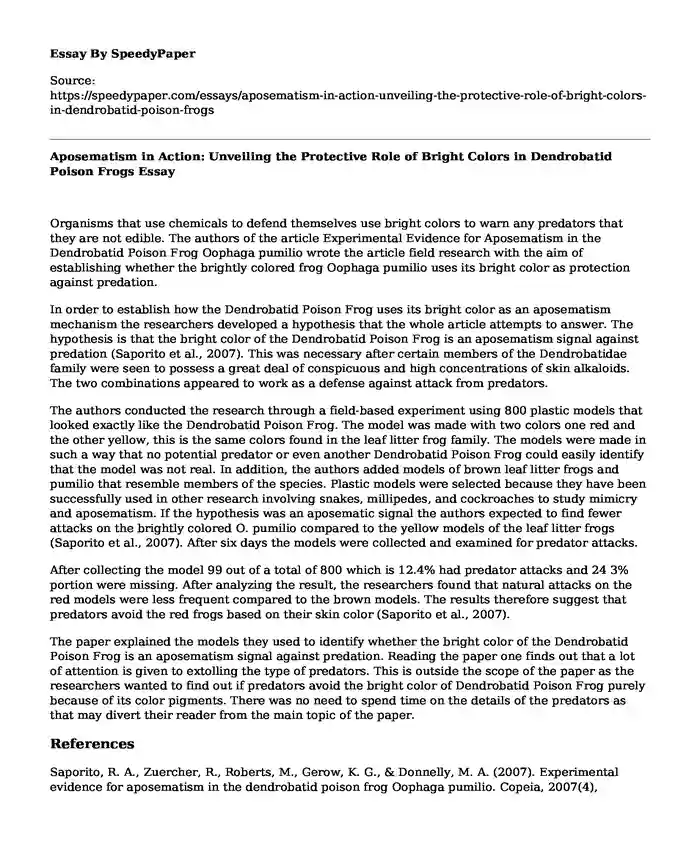Organisms that use chemicals to defend themselves use bright colors to warn any predators that they are not edible. The authors of the article Experimental Evidence for Aposematism in the Dendrobatid Poison Frog Oophaga pumilio wrote the article field research with the aim of establishing whether the brightly colored frog Oophaga pumilio uses its bright color as protection against predation.
In order to establish how the Dendrobatid Poison Frog uses its bright color as an aposematism mechanism the researchers developed a hypothesis that the whole article attempts to answer. The hypothesis is that the bright color of the Dendrobatid Poison Frog is an aposematism signal against predation (Saporito et al., 2007). This was necessary after certain members of the Dendrobatidae family were seen to possess a great deal of conspicuous and high concentrations of skin alkaloids. The two combinations appeared to work as a defense against attack from predators.
The authors conducted the research through a field-based experiment using 800 plastic models that looked exactly like the Dendrobatid Poison Frog. The model was made with two colors one red and the other yellow, this is the same colors found in the leaf litter frog family. The models were made in such a way that no potential predator or even another Dendrobatid Poison Frog could easily identify that the model was not real. In addition, the authors added models of brown leaf litter frogs and pumilio that resemble members of the species. Plastic models were selected because they have been successfully used in other research involving snakes, millipedes, and cockroaches to study mimicry and aposematism. If the hypothesis was an aposematic signal the authors expected to find fewer attacks on the brightly colored O. pumilio compared to the yellow models of the leaf litter frogs (Saporito et al., 2007). After six days the models were collected and examined for predator attacks.
After collecting the model 99 out of a total of 800 which is 12.4% had predator attacks and 24 3% portion were missing. After analyzing the result, the researchers found that natural attacks on the red models were less frequent compared to the brown models. The results therefore suggest that predators avoid the red frogs based on their skin color (Saporito et al., 2007).
The paper explained the models they used to identify whether the bright color of the Dendrobatid Poison Frog is an aposematism signal against predation. Reading the paper one finds out that a lot of attention is given to extolling the type of predators. This is outside the scope of the paper as the researchers wanted to find out if predators avoid the bright color of Dendrobatid Poison Frog purely because of its color pigments. There was no need to spend time on the details of the predators as that may divert their reader from the main topic of the paper.
References
Saporito, R. A., Zuercher, R., Roberts, M., Gerow, K. G., & Donnelly, M. A. (2007). Experimental evidence for aposematism in the dendrobatid poison frog Oophaga pumilio. Copeia, 2007(4), 1006-1011.
Cite this page
Aposematism in Action: Unveiling the Protective Role of Bright Colors in Dendrobatid Poison Frogs. (2024, Jan 24). Retrieved from https://speedypaper.com/essays/aposematism-in-action-unveiling-the-protective-role-of-bright-colors-in-dendrobatid-poison-frogs
Request Removal
If you are the original author of this essay and no longer wish to have it published on the SpeedyPaper website, please click below to request its removal:
- Mr. President,
- Free Essay for Students on Disaster Readiness
- Free Essay Sample on Municipal Situation
- Free Essay Sample - the Economic Impacts of Natural Disasters
- Case of Hurricane Katrina - Essay Sample
- James McAllister: Learning from BP and NASA Case Analysis
- Hurricane Katrina Analysis - Essay Sample
Popular categories





